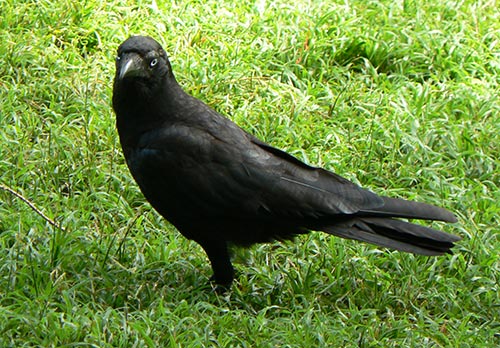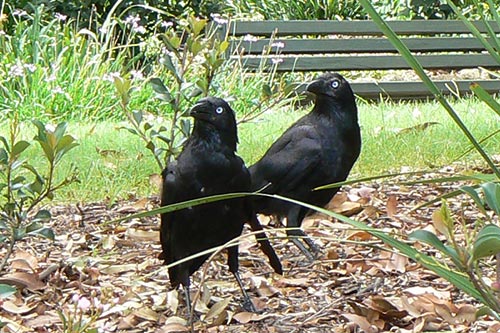Birds
Advice, Capture & Removal
Torresian Crow
Covus orru
Other common names: Australian Crow, Crow, Kelly, Large-billed Crow.
Please note: crows are by far the most challenging of birds to trap. They are highly cognitive and often efforts for trapping simply do not work. Crow trapping can be time consuming and subsequently quite expensive. Please consider this before inquiring about crow removal.
Physical description
- Large black bird achieving an average body length of 48-55cm.
- Feathers wholly black, with the neck and head feathers having white bases, and the coat alluring an oily sheen. The eye is white with a blue inner ring.
- Characteristically shuffles its wings upon landing
- Sexes alike, with juveniles duller black and brown eyes.
Ecology
- Common and widespread across northern and central Australia. The western population is isolated by the Simpson and Great Sandy Deserts.
- Found in a wide range of habitat types from rainforest fringes, open forests and woodlands, scrublands, heathlands, grasslands, farmlands ands coastal environments.
- Diet consists of a variety of insects, crops and more commonly carrion (dead animals). It eats the most grain in comparison to other corvids (crows and ravens). It has also adapted to eat the poisonous introduced Cane Toad Bufo marinus by flipping the toad onto its back and attacking it through its soft belly.
- Torresian Crows may reside permanently in an area once a suitable territory is established.
Breeding
- Breeding occurs from August or September to October, but sometimes through to January or February if conditions are favourable.
- Nests are built high up in the tree canopy, generally more than 10 meters high, and generally in an upright fork of a branch. It consists of a large bowl constructed with dry sticks, and the centre lined with shredded bark, wool and some grasses matted together to make a thick layer. These nests are sturdily built and may last many years.
- Clutches consist of 4 to 5 bluish, spotted eggs, 44mm x 30mm in size and oval in shape.
- The female solely incubates the eggs, and both parents share in feeding the chicks.
Surburn Torresian Crows
- The Torresian Crow is a native Australian bird and is protected under state legislation.
- One of the most common birds found in Brisbane.
- They play an important role in natural pest management, preying on insects and mice around crops, woodlands and suburban gardens. Crows remove road kill and disperse native seeds through defecation.
- Emitting a loud, raucous call, they can often be an audible nuisance in urban areas.
- Torresian Crows have a bad habit of scavenging for food in rubbish bins, which can made local parks and gardens unsightly.
- In some instances crows are known to swoop passers by to protect their nests.

Clever & always alert
Living with Suburban Torresian Crows
Crows as shown above are an integral part of our highly modified suburban landscape. However the sound of these birds in full chorus for extended periods of time is enough to drive you to distraction. Forget the fake snakes and birds of prey, these have been proven time and again to be of no assistance. We suggest the following as more effective but not always successful ways to deter crows. Remember these birds are highly intelligent and even expert bird relocators have been foiled by cunning crows.
So what can you do to try and deter an swooping Magpie in your yard?
Noisy crows
- Don’t feed crows or leave rubbish out. Ensure your bin lids are securely shut to prevent cunning crows from breaking in.
- Remove water sources from your yard.
- The strategic removal of individual tree branches may encourage the birds to roost and perch elsewhere.
Swooping crows
- Don’t interfere with the bird, its nest or the chicks.
- Crows are a protected species under Australian law and attempts to harm or kill these birds are illegal. These birds are merely protecting there young from a perceived intruder in much the same we would our own children.
- Don’t feed crows. It is commonly believed that by feeding these birds they become friendly and won’t become a nuisance. The truth is it encourages other animals into the area to take advantage of a free feed.
- Avoid the area. If there is an alternate way of getting to work, going to the shops or taking the kids to school then use it instead. It’s a small price to pay when considering a potential injury.
- Where possible keep your eye on the bird. In most cases the bird will not swoop and make contact if it sees you are watching. If the bird does approach the simple waving of an arm will deter it from making physical contact.
- Carrying a hat, umbrella or alternate object which you can hold above you head can help in deterring birds from swooping. Walking in a group can also be a great tactic.
- Placing eyespots on your bike helmet, wearing sunglasses on the back of your head or keeping the bird in eye contact may in some cases help prevent swooping. Crows like magpies utilise the element of a surprise attack when you’re not looking. Therefore maintaining eye contact, or the illusion that you are, may as previously mentioned aid in deterring them.
- Don’t harass the birds, as this can make them more aggressive and more likely to injury someone else.
- Informing your local council and having them erect signs is a great way of informing residents of swooping birds in the area so they are aware of the temporary risk.
Advice & Relocation
If your best efforts of deterring the bird fail then further advice or relocation may be your last resort. Ecologically-minded crow advice, specialist trapping requirements, and ecologically sound translocation methods are employed by licensed professionals for effective crow relocation.
Please note: crows are by far the most challenging of birds to trap. They are highly cognitive and often efforts for trapping simply do not work. Crow trapping can be time consuming and subsequently quite expensive. Please consider this before inquiring about crow removal.
Trapping & relocation of the bird is done in accordance with requirements stipulated by the Environmental Protection Agency and permits are issued after stringent examination as to knowledge and suitability to actively manage conflict crows.
Every effort is made to ensure the birds are managed as to welfare, and to minimize any possible harm whilst being trapped, upon trapping, and through transit to a suitable release site.
Brisbane West including The Gap, Bardon, Chapel Hill, Kenmore, Brookfield, Sinnamon Park Oxley, Algester, Forestdale and surrounding suburbs
0413 028 081
Ipswich and surrounding suburbs
0413 028 081
Brisbane North, including Moreton Bay Regional council areas south of Caboolture
0413 028 081
Brisbane South including Moorooka, Yeronga, Woolloongabba, Wynnum, Cleveland, Carindale, Holland Park, Marsden
0421 455 077
Gold Coast all suburbs
0418 738 228
